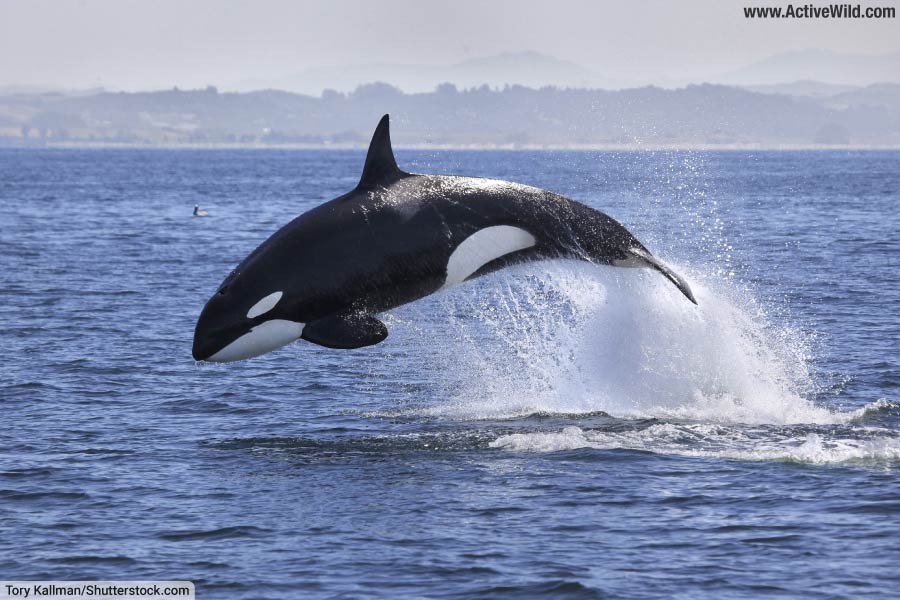With a population numbering several million, the common dolphin is the world’s most abundant cetacean. Living in large pods that can contain thousands of individuals, the common dolphin is known for its acrobatics and is often seen riding the bow waves of boats.
Read on to find out more about this amazing marine mammal...
Common Dolphin Introduction

The common dolphin (Delphinus delphis) belongs to the oceanic dolphin family Delphinidae and is widely distributed across warm-temperate and tropical oceans globally. Known for its playful and acrobatic behavior, the marine mammal can reach lengths up to 2.5 meters and weights of between 80 and 150 kg.
This species can be recognized by its distinctive hourglass color pattern, streamlined body and long, slender beak. It is currently (June 2023) listed as "Least Concern" by the IUCN, highlighting its relatively healthy population status.
Page Index
- Common Dolphin Introduction
- Common Dolphin Facts & Figures
- Physical Description
- Family & Related Animals: Common Dolphin Taxonomy
- Where Is The Common Dolphin Found? Range & Habitat
- What Does The Common Dolphin Eat? Diet
- Behavior & Life Cycle
- Is The Common Dolphin Endangered?
- Common Dolphin vs Bottlenose Dolphin
Related Pages
- Pictures and facts on every species of dolphin: Types of Dolphins
- Discover the difference between dolphins and porpoises: Dolphin vs Porpoise
Common Dolphin Facts & Figures
- Scientific Name: Delphinus delphis
- Order: Cetacea
- Family: Delphinidae (the oceanic dolphin family)
- Length: 1.9 to 2.5 meters (6.2 to 8.2 feet)
- Weight: Between 80 and 150 kg (176 and 331 lb)
- Where found: The common dolphin is widespread in both warm-temperate and tropical oceans around the world, including the Atlantic and Pacific Oceans.
- IUCN conservation status (June 2023): Least Concern
Physical Description

The common dolphin is a mid-sized dolphin with a sleek body and a distinctive “hourglass” pattern on its sides. It can reach a length of up to 2.5 meters (8.2 feet) and a weight of between 80-150 kg (176-331 lb). Its back is typically black or dark gray, while the underbelly is white. The hourglass pattern on the sides is light grey or yellowish in color and tapers towards the tail.
The common dolphin has a long, slender beak filled with as many as 50 small, sharp, conical teeth on each side of both jaws. The dorsal fin is prominent and sickle-shaped, and its pectoral flippers are medium-length and pointed. With a body built for swift, efficient swimming, the common dolphin is famed for its playful and acrobatic antics.
Common Dolphin Taxonomy
The common dolphin is a cetacean – a member of the infraorder Cetacea, which encompasses all marine mammals commonly known as whales, dolphins, and porpoises.
Within this order, the common dolphin belongs to the family Delphinidae, often referred to as the oceanic dolphin family. This group is large and varied, with about 36 species, including well-known members such as the bottlenose dolphin and the killer whale.

Traditionally, two species of common dolphin were recognized: the short-beaked common dolphin (Delphinus delphis) and the long-beaked common dolphin (Delphinus capensis).
In 2015, genetic studies found that the two forms of common dolphin should be considered a single species (Delphinus delphis). The common dolphin is the only species of genus Delphinus.
Some authorities (including the current (June 2023) mammal species of the world) still recognize the original distinction.
The two forms of common dolphin are similar in appearance, with primary differences in their beak lengths and geographic distributions. The two forms do overlap in certain geographic regions and can interbreed.
Four common dolphin subspecies are currently recognized:
Common Dolphin Subspecies
- Common dolphin (Delphinus delphis delphis)
- Eastern North Pacific long-beaked common dolphin (D. d. bairdii)
- Black Sea common dolphin (D. d. ponticus)
- Indo-Pacific common dolphin (D. d. tropicalis)
Where Is The Common Dolphin Found? Range & Habitat
Common dolphins are one of the most widely distributed marine mammal species, found in both warm-temperate and tropical oceans globally. Their range includes the Atlantic, Indian and Pacific Oceans, from the coastal waters of continents and islands to the open ocean.
In the Atlantic, they can be found from Nova Scotia in Canada to Florida in the United States and further south to Argentina in the Western Atlantic, and from Norway to the tip of South Africa in the Eastern Atlantic, including the Mediterranean and Black Sea.
In the Pacific Ocean, the common dolphin is found from the cooler waters off Russia in the north to the warmer waters off Chile in the south. This includes coastal regions as well as the open ocean.
In the Eastern Pacific, their range extends from Northern California down to the tip of Baja California in Mexico, and further south to Peru and Chile. They are also commonly seen around the Hawaiian Islands and other Pacific island chains.
In the Western Pacific, common dolphins can be found from the waters off Japan in the north, down the coastlines of China, the Philippines, and Australia, all the way to New Zealand in the south. They are also present in the waters around many of the islands in the South Pacific.
Habitat
The habitat preference of the common dolphin is varied and includes both offshore and coastal waters. In coastal areas, common dolphins are usually found in areas where the seafloor drops off sharply and where upwelling of deep, nutrient-rich waters encourages a high productivity of marine life.
In the open ocean, common dolphins are often found in warm waters, including the Gulf Stream in the North Atlantic and in areas with convergence zones where different currents meet, resulting in an abundance of food.
What Does The Common Dolphin Eat?

The common dolphin’s diet primarily consists of small schooling fish such as anchovies, sardines and mackerel, and squid. The exact composition of its diet can vary depending on their geographic location and the local abundance of prey species.
Common dolphins are known for their cooperative hunting behavior. They often work together to herd fish into tight balls, taking turns to swim through and feed.
Behavior
The common dolphin is highly social, living in pods that can contain hundreds, sometimes thousands of individuals. (“Mega-pods”, containing up to 10,000 dolphins, are known.)
The common dolphin also associates with other dolphin species, including the spinner dolphin, striped dolphin and spotted dolphin.
Common Dolphin Life Cycle
The female common dolphin gives birth to a single calf after a gestation period of about 10 to 12 months. Females can give birth every 1 to 3 years.
Newborns are usually around 0.8-1 meter in length. The calf will nurse from its mother for up to 19 months, but it may start to eat small amounts of fish after a few months.
Females typically reach sexual maturity at around 6-7 years, while males become mature at about 10-12 years.
The lifespan of a common dolphin typically ranges between 20 to 25 years, although some individuals have been known to live up to 40 years.
Threats faced by the common dolphin include predation from large shark species and killer whales, and human-induced threats such as bycatch in fishing gear.
Is The Common Dolphin Endangered?
The common dolphin is the world’s most abundant cetacean, with several million common dolphins being distributed throughout the world’s oceans.
Due to its abundance, wide range, and lack of immediate threats, the common dolphin has the IUCN conservation status “Least Concern”.
Threats faced by the species include being caught as bycatch (accidental capture by fishermen targeting other species) and lack of prey as a result of overfishing.
Common Dolphin vs Common Bottlenose Dolphin

Although the common dolphin is the world’s most abundant dolphin, to most people the bottlenose dolphin is the “typical” dolphin.
Both the common dolphin (Delphinus delphis) and the common bottlenose dolphin (Tursiops truncatus) are members of the Delphinidae family.
Physically, common dolphins are usually smaller, reaching lengths of up to 2.5 meters (8.2 feet), compared to the bottlenose dolphin, which can grow up to 3.9 meters (12.8 feet) long. The common dolphin is also distinctively marked with an hourglass pattern on its sides, while the bottlenose dolphin has a more uniformly gray coloration.
In terms of behavior, both species are known for their intelligence and social nature, but bottlenose dolphins have been studied more extensively due to their coastal habits and are often seen in captivity, making them more familiar to the public. Bottlenose dolphins are also known to have a longer lifespan, living up to 50 years compared to the common dolphin's typical lifespan of 20-25 years.
When it comes to habitats, both species have a wide distribution. However, common dolphins are more typically found in warmer offshore waters, while bottlenose dolphins can adapt to a variety of marine and estuarine environments, including coastal habitats.
Both species are currently classified by the IUCN as "Least Concern".
Discover More with Active Wild
You can see pictures and facts on every species of dolphin on this page: Types of Dolphins
Do you know the difference between dolphins and porpoises? Dolphin vs Porpoise
Discover different types of mammals on this page: Types of Mammals
Discover more amazing animals with a complete guide to the animal kingdom: Animals

